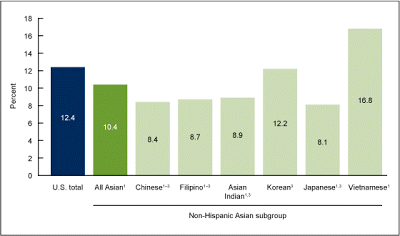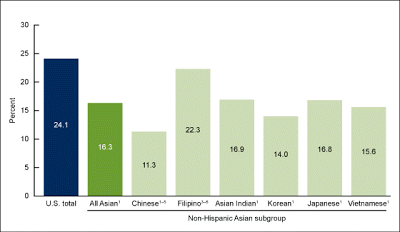Asian American adults are the healthiest, both physically and psychologically, in the United States, according to data released by the Centers for Disease Control and Prevention. The report also refutes the notion that all Asian Americans can be viewed as one mononlithic group when treating their health ailments.
Of the group, which included Chinese, Filipinos, Asian Indians, Japanese, Vietnamese and Koreans, Chinese “reported better health on all five measures in this report compared with all U.S. adults.”
Among the key findings:
- Non-Hispanic Asian adults were less likely than all U.S. adults to be in fair or poor health, have multiple chronic conditions, have serious psychological distress in the past 30 days, or be limited in work or social participation.
- Chinese adults reported better health on all five measures in this report compared with all U.S. adults.
- Chinese adults (11.3 percent) were less likely than Filipino (22.3 percent), Asian Indian (16.9 percent), Japanese (16.8 percent), or Vietnamese (15.6 percent) adults to have multiple chronic conditions.
- Vietnamese may have the worse health outcomes of all Americans.

Figure 1. Age-adjusted percentage of adults aged 18 and over in fair or
poor health, by non-Hispanic Asian subgroup: United States, 2010–2014
- Chinese (1.8 percent) and Asian Indian (1.5 percent) adults were about one-half as likely as Japanese adults (4.1 percent) to have a work limitation.
- Chinese (2.4 percent), Japanese (2.2 percent), and Vietnamese (2.4 percent) adults were about one-half as likely as Korean adults (4.6 percent) to be limited in social participation.
- Filipinos reported the most chronic conditions, while Japanese experienced the most work limitations.

Figure 2. Age-adjusted percentage of adults aged 18 and over with multiple
chronic conditions, by non-Hispanic Asian subgroup: United States, 2010–2014 - Korean and Asian Indian adults were more likely to report limitations in social behavior, but neither group was more likely to have multiple chronic conditions or serious psychological distress.
- As pointed out by the Huffington Post, one of the flaws of the study is that it was skewed towards English speakers, which would leave out older non-English-speakers who probably be in poorer health.
LATEST STORIES










